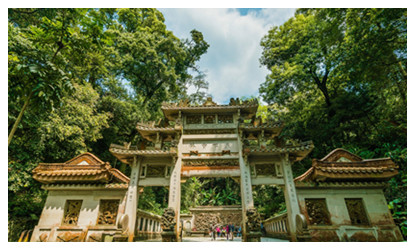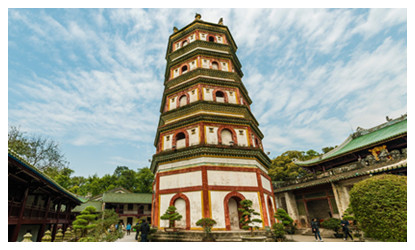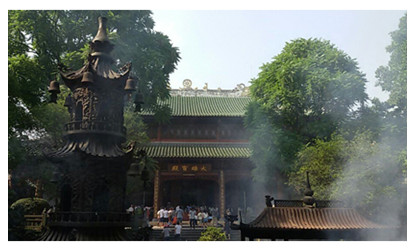Skype: neodalle-travel
Tel: +86 135 7447 2266
E-mail: sales@zhangjiajieholiday.com
What to see?
 Leaning against mountains, the south-facing temple covers an area of more than 42.5 hectares. It has a set of magnificent Buddhist buildings, including the Hall of Heavenly Kings, the Grand Hall, Sutra Depository, Sixth Ancestor Hall, Lingzhao Pagoda and 690 Buddhist statues. Most of the buildings were renovated in 1934 as the original temple was damaged several times. The new one preserves the distinctive characteristics of Chinese ancient architecture and the buildings are rhythmically arrayed along the central axis.
Leaning against mountains, the south-facing temple covers an area of more than 42.5 hectares. It has a set of magnificent Buddhist buildings, including the Hall of Heavenly Kings, the Grand Hall, Sutra Depository, Sixth Ancestor Hall, Lingzhao Pagoda and 690 Buddhist statues. Most of the buildings were renovated in 1934 as the original temple was damaged several times. The new one preserves the distinctive characteristics of Chinese ancient architecture and the buildings are rhythmically arrayed along the central axis.
Heavenly Kings Hall
The majestic Hall of Heavenly Kings was originally built in 1474 during the Ming Dynasty (1368-1644) and rebuilt in the Qing Dynasty (1644-1911). The statue of Maitreya is enshrined in the hall and the mighty statues of the four Heavenly Kings holding religious objects stand on both sides of the statue of Maitreya. Behind the hall is a three- storey bell tower which was constructed in 1301 of the Yuan Dynasty (1271-1368). On top of the bell tower, there hangs a brass bell from the Southern Song Dynasty (1127-1279). The massive bell is 2.75 meters high with a diameter of 1.8 meters.
storey bell tower which was constructed in 1301 of the Yuan Dynasty (1271-1368). On top of the bell tower, there hangs a brass bell from the Southern Song Dynasty (1127-1279). The massive bell is 2.75 meters high with a diameter of 1.8 meters.
The Grand Hall
The Grand Hall, constructed in 1306 during the Yuan Dynasty (1271-1368), stands in the center of the temple. Covered by glazed tiles, the grandiosity of the building is inferior to none in the Buddhist constructions of Guangdong Province. The sublime statues of Sakyamuni, Medicine Buddha and Amitabha are situated in the sacrarium of the hall. The gilded figures are all over 8.3 meters high, giving a feeling of loftiness and magnificence. Besides, there are about 500 fine clay sculptures of Buddhist arhats inside the hall. With a wavy sea sculpted out of clay as the background, the clay sculptures mix with the lofty mountains and seas, expressing profound Buddhist meaning.
Cultural Relics
 The temple holds many precious cultural relics; the most precious being the statue of Hui Neng, which is worshiped in the Sixth Ancestor Hall. There are 360 Buddhist arhats figures which are the only Chinese wooden carvings preserved from the Northern Song Dynasty (960-1127). It is notable that the lifelike figures have been made by highly-skilled carvers and each of them has a distinct sitting posture, representing the different characters of the arhats. Some were engraved with epigraphs which are of high value. The rare cassock trimmed with dainty embroidery of over 1,000 Buddhist figures is also worth mentioning. Many of the valuable cultural relics being kept in the temple are national treasure and significant in the study of Chinese architecture, sculpture, painting and Buddhism.
The temple holds many precious cultural relics; the most precious being the statue of Hui Neng, which is worshiped in the Sixth Ancestor Hall. There are 360 Buddhist arhats figures which are the only Chinese wooden carvings preserved from the Northern Song Dynasty (960-1127). It is notable that the lifelike figures have been made by highly-skilled carvers and each of them has a distinct sitting posture, representing the different characters of the arhats. Some were engraved with epigraphs which are of high value. The rare cassock trimmed with dainty embroidery of over 1,000 Buddhist figures is also worth mentioning. Many of the valuable cultural relics being kept in the temple are national treasure and significant in the study of Chinese architecture, sculpture, painting and Buddhism.
Travel Tips
Add: Maba Town, Qujiang District, about 22 kilometers southeast from downtown Shaoguan City, northern Guangdong Province.
Entrance fee: CNY 20
Opening Hours: 09:00-17:30
http://www.nhcs.cn/
Tel: 0751-6501014,0751-6502258
 Ask Questions ?
Ask Questions ?